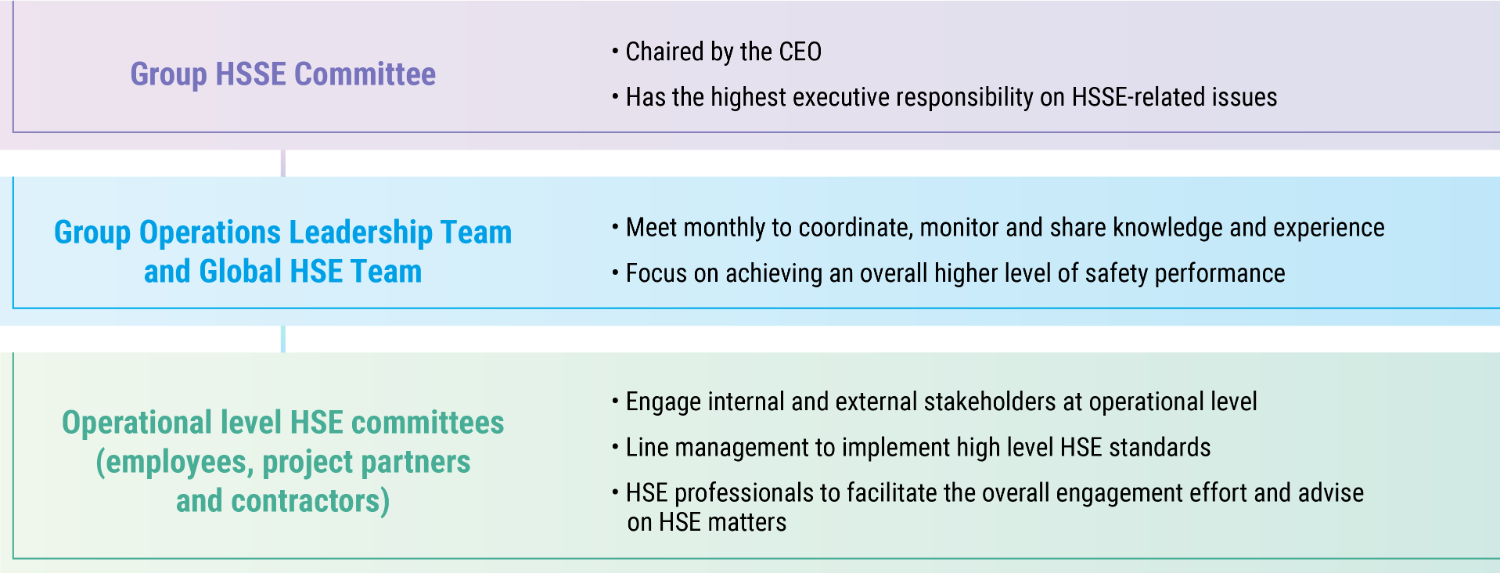- At the Group level, Human and Organisational Performance & Learning Team training pilot programmes commenced in some of CLP's business units, providing staff with core skills to support their teams in learning and driving performance improvement. Central to the success of this programme is the formation of operational Learning Teams who will actively seek to understand and solve issues faced by those working on the frontline.
- EnergyAustralia continued to implement a new science-based safety programme called "Advanced Error Reduction in Organisations (AERO)". AERO provides tools to help employees understand their personality tendencies, so that they can more easily recognise and manage error traps associated with certain tasks. New Manual Handling programmes were initiated at Mount Piper and Yallourn.
- In Mainland China, Fangchenggang introduced a Safety Culture Transformation Team to uplift its safety culture and work safety through initiating a series of safety improvement programs and activities titled, “I want to be safe; I can be safe; I will be safe; Build safety together”.
Safety
Occupational health and safety
Group safety performance | 2021 | 2020 | 2019 | 2018 | 2017 |
|---|---|---|---|---|---|
Employees1 | |||||
Fatalities (number of personnel)2,3 | 0 | 0 | 0 | 1 | 0 |
Fatality Rate (number per 200,000 work hours)4,5 | 0.00 | 0.00 | 0.00 | 0.01 | 0.00 |
Days Away From Work Injuries (number of personnel)3,6 | 4 | 12 | 7 | 11 | 11 |
Lost Time Injury Rate | 0.05 | 0.13 | 0.07 | 0.13 | 0.13 |
High-consequence Injuries (number of personnel)8 | 0 | N/A | N/A | N/A | N/A |
Total Recordable Injury Rate | 0.14 | 0.25 | 0.19 | 0.19 | 0.21 |
Work-related Ill Health (number of personnel)3,10 | 1 | 0 | 0 | 1 | 0 |
Lost Days (number of days)11 | 30412 | 44313 | 46414 | 249 | 252 |
Contractors1 | |||||
Fatalities (number of personnel)2,3 | 0 | 0 | 1 | 1 | 4 |
Fatality Rate (number per 200,000 work hours)4,5 | 0.00 | 0.00 | 0.01 | 0.01 | 0.03 |
Days Away From Work Injuries (number of personnel)3,6 | 10 | 10 | 19 | 11 | 16 |
Lost Time Injury Rate | 0.08 | 0.09 | 0.14 | 0.09 | 0.14 |
High-consequence Injuries (number of personnel)8 | 1 | N/A | N/A | N/A | N/A |
Total Recordable Injury Rate | 0.29 | 0.37 | 0.52 | 0.29 | 0.36 |
Employees and contractors combined1 | |||||
Fatalities (number of personnel)2,3 | 0 | 0 | 1 | 2 | 4 |
Fatality Rate (number per 200,000 work hours)4,5 | 0.00 | 0.00 | 0.00 | 0.01 | 0.02 |
Days Away From Work Injuries (number of personnel)3,6 | 14 | 22 | 26 | 22 | 27 |
Lost Time Injury Rate | 0.07 | 0.11 | 0.11 | 0.10 | 0.13 |
High-consequence Injuries (number of personnel)8 | 1 | N/A | N/A | N/A | N/A |
Total Recordable Injury Rate | 0.23 | 0.32 | 0.38 | 0.25 | 0.29 |
- The system of rules applied in recording and reporting accident statistics complies with the International Labour Organization (ILO) Code of Practice on Recording and Notification of Occupational Accidents and Diseases.
- Refers to the number of fatalities as a result of work-related injury.
- Starting from 2021, the unit is changed from the number of cases to the number of personnel.
- Refers to the number of fatal injuries per 200,000 work hours in the year.
- Rates are normalised to 200,000 work hours, which approximately equals to the number of hours worked by 100 people in one year.
- Starting from 2021, “Days Away From Work Injuries” replaces “Lost Time Injury”. Days Away From Work Injuries refers to the number of personnel who sustains work-related injury and is unfit to perform any work on any day after the occurrence of the injury. “Any day” is any calendar day which includes rest days, weekend days, leave days, public holidays or days after ceasing employment. It does not include the day the injury incident occurred. “Days Away From Work Injuries” excludes fatalities which were included in “Lost Time Injury”. Numbers prior to 2021 are the previously reported numbers for “Lost Time Injury”.
- Refers to the number of Days Away From Work Injuries and Fatalities per 200,000 work hours in the year.
- Refers to the number of personnel who sustains life threatening or life-altering work-related injury. It is a subset of Days Away From Work Injuries.
- Refers to the number of Total Recordable Injuries per 200,000 work hours in the year. Total Recordable Injuries include Fatalities, Days Away From Work Injuries, Restricted Work Injuries, and Medical Treatment Injuries.
- Starting from 2021, “Work-related Ill Health” replaces “Occupational Disease”. Work-related Ill Health includes the diseases listed in the ILO List of Occupational Diseases, work-related mental illnesses and work-related disorders. Numbers prior to 2021 are the previously reported numbers for “Occupational Disease”.
- Starting from 2021, “Lost Days” replaces “Days Lost”. “Lost Days” is the sum total of calendar days (consecutive or otherwise) after the days on which the work-related injuries and work-related ill health occurred. “Days Lost” accounts the working days instead of calendar days. Numbers prior to 2021 are the previously reported numbers for “Days Lost”.
- 19 out of 304 days were carried forward from one incident in 2020.
- 188 out of 443 days were carried forward from one incident in the past.
- 158 out of 464 days were carried forward from three incidents in the past.
Regional safety performance | 2021 | 2020 | 20191 | 2018 | 2017 |
|---|---|---|---|---|---|
CLP Holdings2 | |||||
Employees | |||||
Fatalities (number of personnel) | 0 | 0 | 0 | 0 | 0 |
Fatality Rate (number per 200,000 work hours) | 0.00 | 0.00 | 0.00 | 0.00 | 0.00 |
Days Away from Work Injuries | 0 | 0 | 0 | 0 | 0 |
Lost Time Injury Rate | 0.00 | 0.00 | 0.00 | 0.00 | 0.00 |
High-consequence Injuries | 0 | N/A | N/A | N/A | N/A |
Total Recordable Injury Rate | 0.13 | 0.00 | 0.00 | 0.00 | 0.00 |
Work-related Ill Health (number of personnel) | 0 | 0 | 0 | 0 | 0 |
Lost Days (number of days) | 0 | 0 | 0 | 0 | 0 |
Contractors | |||||
Fatalities (number of personnel) | 0 | 0 | 1 | 0 | 0 |
Fatality Rate (number per 200,000 work hours) | 0.00 | 0.00 | 0.24 | 0.00 | 0.00 |
Days Away from Work Injuries | 0 | 0 | 2 | 0 | 0 |
Lost Time Injury Rate | 0.00 | 0.00 | 0.48 | 0.00 | 0.00 |
High-consequence Injuries | 0 | N/A | N/A | N/A | N/A |
Total Recordable Injury Rate | 0.22 | 0.00 | 0.48 | 0.00 | 0.00 |
Hong Kong2 | |||||
Employees | |||||
Fatalities (number of personnel) | 0 | 0 | 0 | 0 | 0 |
Fatality Rate (number per 200,000 work hours) | 0.00 | 0.00 | 0.00 | 0.00 | 0.00 |
Days Away from Work Injuries | 0 | 4 | 4 | 5 | 1 |
Lost Time Injury Rate | 0.00 | 0.09 | 0.09 | 0.10 | 0.02 |
High-consequence Injuries | 0 | N/A | N/A | N/A | N/A |
Total Recordable Injury Rate | 0.02 | 0.21 | 0.19 | 0.15 | 0.08 |
Work-related Ill Health (number of personnel) | 0 | 0 | 0 | 0 | 0 |
Lost Days (number of days) | 0 | 119 | 246 | 120 | 47 |
Contractors | |||||
Fatalities (number of personnel) | 0 | 0 | 0 | 0 | 4 |
Fatality Rate (number per 200,000 work hours) | 0.00 | 0.00 | 0.00 | 0.00 | 0.07 |
Days Away from Work Injuries | 4 | 5 | 15 | 5 | 9 |
Lost Time Injury Rate | 0.07 | 0.10 | 0.21 | 0.08 | 0.16 |
High-consequence Injuries | 0 | N/A | N/A | N/A | N/A |
Total Recordable Injury Rate | 0.14 | 0.30 | 0.51 | 0.20 | 0.29 |
Mainland China2 | |||||
Employees | |||||
Fatalities (number of personnel) | 0 | 0 | 0 | 0 | 0 |
Fatality Rate (number per 200,000 work hours) | 0.00 | 0.00 | 0.00 | 0.00 | 0.00 |
Days Away from Work Injuries | 0 | 2 | 0 | 0 | 0 |
Lost Time Injury Rate | 0.00 | 0.19 | 0.00 | 0.00 | 0.00 |
High-consequence Injuries | 0 | N/A | N/A | N/A | N/A |
Total Recordable Injury Rate | 0.00 | 0.19 | 0.10 | 0.00 | 0.00 |
Work-related Ill Health (number of personnel) | 0 | 0 | 0 | 0 | 0 |
Lost Days (number of days) | 19 | 59 | 0 | 0 | 0 |
Contractors | |||||
Fatalities (number of personnel) | 0 | 0 | 0 | 0 | 0 |
Fatality Rate (number per 200,000 work hours) | 0.00 | 0.00 | 0.00 | 0.00 | 0.00 |
Days Away from Work Injuries | 0 | 1 | 0 | 0 | 0 |
Lost Time Injury Rate | 0.00 | 0.10 | 0.00 | 0.00 | 0.00 |
High-consequence Injuries | 0 | N/A | N/A | N/A | N/A |
Total Recordable Injury Rate | 0.08 | 0.49 | 0.00 | 0.07 | 0.06 |
Australia2 | |||||
Employees | |||||
Fatalities (number of personnel) | 0 | 0 | 0 | 1 | 0 |
Fatality Rate (number per 200,000 work hours) | 0.00 | 0.00 | 0.00 | 0.04 | 0.00 |
Days Away from Work Injuries | 4 | 6 | 3 | 6 | 10 |
Lost Time Injury Rate | 0.18 | 0.25 | 0.10 | 0.26 | 0.43 |
High-consequence Injuries | 0 | N/A | N/A | N/A | N/A |
Total Recordable Injury Rate | 0.45 | 0.46 | 0.31 | 0.44 | 0.60 |
Work-related Ill Health (number of personnel) | 1 | 0 | 0 | 1 | 0 |
Lost Days (number of days) | 285 | 265 | 218 | 129 | 205 |
Contractors | |||||
Fatalities (number of personnel) | 0 | 0 | 0 | 1 | 0 |
Fatality Rate (number per 200,000 work hours) | 0.00 | 0.00 | 0.00 | 0.06 | 0.00 |
Days Away from Work Injuries | 5 | 2 | 2 | 4 | 6 |
Lost Time Injury Rate | 0.40 | 0.11 | 0.12 | 0.26 | 0.62 |
High-consequence Injuries | 0 | N/A | N/A | N/A | N/A |
Total Recordable Injury Rate | 0.97 | 0.44 | 0.62 | 1.09 | 1.85 |
India2 | |||||
Employees | |||||
Fatalities (number of personnel) | 0 | 0 | 0 | 0 | 0 |
Fatality Rate (number per 200,000 work hours) | 0.00 | 0.00 | 0.00 | 0.00 | 0.00 |
Days Away from Work Injuries | 0 | 0 | 0 | 0 | 0 |
Lost Time Injury Rate | 0.00 | 0.00 | 0.00 | 0 | 0.00 |
High-consequence Injuries | 0 | N/A | N/A | N/A | N/A |
Total Recordable Injury Rate | 0.00 | 0.00 | 0.00 | 0.00 | 0.00 |
Work-related Ill Health (number of personnel) | 0 | 0 | 0 | 0 | 0 |
Lost Days (number of days) | 0 | 0 | 0 | 0 | 0 |
Contractors | |||||
Fatalities (number of personnel) | 0 | 0 | 0 | 0 | 0 |
Fatality Rate (number per 200,000 work hours) | 0.00 | 0.00 | 0.00 | 0.00 | 0.00 |
Days Away from Work Injuries | 1 | 2 | 0 | 2 | 1 |
Lost Time Injury Rate | 0.03 | 0.07 | 0.00 | 0.06 | 0.03 |
High-consequence Injuries | 1 | N/A | N/A | N/A | N/A |
Total Recordable Injury Rate | 0.41 | 0.46 | 0.68 | 0.19 | 0.20 |
- Starting from 2019, CLPe Solutions has been reported under CLP Holdings to align with a change in internal reporting. Before that, it was reported under Hong Kong.
- The system of rules applied in recording and reporting accident statistics complies with the International Labour Organization (ILO) Code of Practice on Recording and Notification of Occupational Accidents and Diseases.
Nuclear safety | 2021 | 2020 | 2019 | 2018 | 2017 |
|---|---|---|---|---|---|
Workers | |||||
Collective radiation dosage for workers | 642 | 676 | 960 | 753 | 712 |
Nuclear-related waste | |||||
Spent nuclear fuel (t) | 33.1 | 37.7 | 75.2 | 37.6 | 39.7 |
Low- to intermediate-level radioactive nuclear waste (m3) | 26.0 | 71.0 | 89.4 | 79.0 | 89.2 |
2021 data shaded in orange has been independently verified by PricewaterhouseCoopers. The assurance scope of past years' data can be found in previous Sustainability Reports.
Overview
Copy linkCopied link
Caring for people is one of the core components of CLP’s Value Framework. The continued health and safety of all parties is always a top priority for the Group.
While stakeholder expectations continually evolve, safety is fundamental; employees, contractors, customers and the communities in which CLP operates rightly expect to be free from harm while on or near CLP premises.
Health and safety is even more pertinent in today’s pandemic reality. Social distancing, temperature monitoring and enhanced hygiene measures are the new normal. Equally important is mental health and wellbeing as many individuals continue to struggle with work-from-home or other COVID-19 pandemic-related restrictions.
As expected, safety and well-being continues to be a material topic for all CLP stakeholders, with a special focus on employees and contractors. The nature of the business potentially exposes individuals to high-risk activities. CLP is responsible for reducing risk by enacting appropriate safety measures or deploying technological solutions. CLP continually monitors the disclosure of metrics relating to customer safety and safety in nuclear plants where it has a non-majority stake.
Key stakeholders
- Customers, Communities, Employees, Suppliers
Related material topics
- Aligning business activities with community, employee and customer expectations
- Promoting workplace safety and wellbeing
Health, Safety, and Environment management
Copy linkCopied link
Occupational health and safety
Copy linkCopied link
Safety around CLP’s network
Copy linkCopied link
Nuclear safety
Copy linkCopied link










